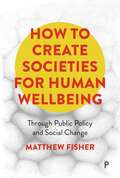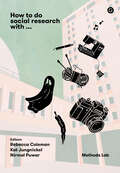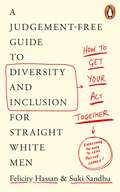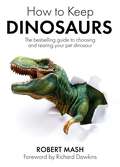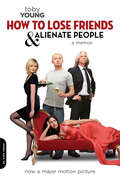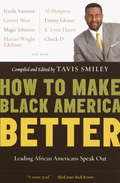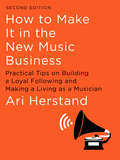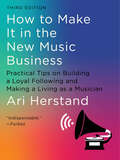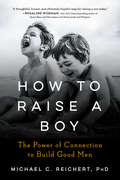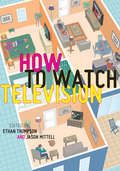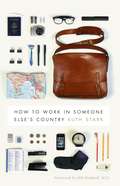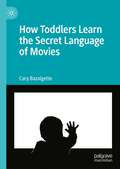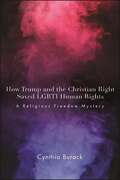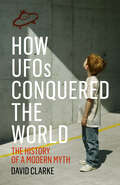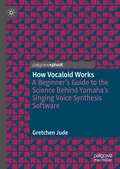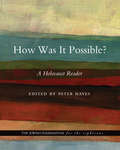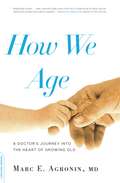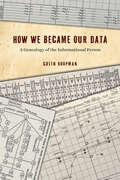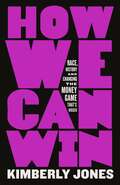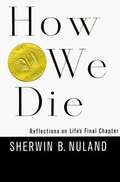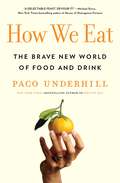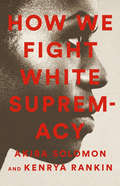- Table View
- List View
How To Create Societies for Human Wellbeing: Through Public Policy and Social Change
by Matthew FisherWellbeing is a hot topic: governments, psychologists and a thousand self-appointed ‘experts’ all claim to promote it and yet our societies are experiencing record levels of mental distress and ill-health. Why? Matthew Fisher presents a compelling new perspective on psychological wellbeing informed by evidence on human stress responses. He shows how our mental health is shaped by the social and cultural conditions in which we all live. Developing arguments and strategies for a society truly committed to wellbeing, this book offers new ways to understand the problems facing modern societies and ways to respond through political and social change.
How To Do Research: 15 Labs for the Social & Behavioral Sciences
by Jane F. Gaultney Hannah D. PeachDesigned to help students make the leap from learning about research to doing research, this manual provides an easy-to-understand walkthrough of the entire research process, from selecting a topic and conducting a literature review through presenting an APA-style paper or presentation. All of the 15 cross-disciplinary labs included are appropriate for use in the social, behavioral, and health sciences, and follow a consistent format: objective, description of a journal article, canned data, examples of what output should look like, pointers on interpreting the output, and a suggested activity for those who wish to collect their own data.
How To Do Research: 15 Labs for the Social & Behavioral Sciences
by Jane F. Gaultney Hannah D. PeachDesigned to help students make the leap from learning about research to doing research, this manual provides an easy-to-understand walkthrough of the entire research process, from selecting a topic and conducting a literature review through presenting an APA-style paper or presentation. All of the 15 cross-disciplinary labs included are appropriate for use in the social, behavioral, and health sciences, and follow a consistent format: objective, description of a journal article, canned data, examples of what output should look like, pointers on interpreting the output, and a suggested activity for those who wish to collect their own data.
How To Do Social Research With (Goldsmiths Press / Methods Lab)
by Rebecca Coleman Nirmal Puwar Kat JungnickelA guide to the doing of critical and creative research with a range of unusual means to apprise places and build ethical relationships.This catalogue of methods draws on the wealth of cutting-edge critical and creative social research from the Goldsmiths Sociology Department to offer an engaged guide to doing research with a range of unexpected relations. The collection focuses on multiple assemblages of objects, media, materials, practices, relations, devices, and atmospheres, spanning methods and topics involving food to activism, knitting to ghosts, theater to documents, collaging to corridors. Through hands-on discussions of the practicalities, ethics, and politics of doing social research, the catalogue showcases a wide range of examples of what methods might mean and do. It builds a case for an understanding of contemporary social research as interdisciplinary, responsive, dynamic, vital, and urgent in studying and shaping social worlds. Goldsmiths Sociology Department is internationally recognized as being at the forefront of some of the most daring, original and unconventional methodological innovation. Their unbounded approach to social research offers textured yet clear paths through the problems and issues before us, as contributors present the methodological puzzles they have become knotted with. The short and imaginative case studies offer new ways of teaching, learning, and doing lively and rigorous research. This is research as close-up observations, infrastructural interventions and imaginative play. How to Do Social Research With … will be essential for anyone interested in expanding their repertoire of social research methods.
How To Get Your Act Together: A Judgement-Free Guide to Diversity and Inclusion for Straight White Men
by Suki Sandhu Felicity Hassan'Obligatory reading for anyone - straight, white and male or otherwise - who wants to do better but doesn't know where to start.' - People Management'A pivotal guide for going from awareness to action in creating a more diverse and inclusive workplace and society.' - Marc Benioff, CEO of Salesforce--------EVERYTHING YOU NEED TO CREATE AND LEAD AN INCLUSIVE, DIVERSE TEAMThe business case for diversity and inclusion is clear - it drives innovation, profit and employer brand. But how can male white leaders help implement this change? There's no denying it's difficult - perhaps you feel left out of the conversation, afraid to make mistakes, and confused about the evolving language of diversity and inclusion.In this practical guide, leading diversity specialists Felicity Hassan and Suki Sandhu OBE teach you how to create an inclusive environment for your employees and have educated conversations about diversity, navigating what can sometimes be tricky territory with humour and heart.--------'A must-read and a powerful call to seize the opportunity that lies in embracing and celebrating people for who they are.' - Richard Branson, CEO & Founder of The Virgin Group'It takes a good deal of self-awareness and continuous learning to really ingrain the behavioural changes that are needed. This book holds up a mirror and then guides us - skilfully and persuasively - to the actions we all need to be taking.' - Alan Jope, CEO of Unilever
How To Keep Dinosaurs: The perfect mix of humour and science
by Robert Mash'Who could resist a handbook about potential pets that has a little symbol for "likes children" and a separate one for "likes children to eat"... wonderful' GUARDIANHollywood and the popular press would have us believe that all dinosaurs are gigantic, hostile and untameable. In fact, there are many species that make charming and even useful companions: Velociraptor - a splendid, loyal, fierce, friendDeinonychus - will not eat dog food (dogs are another matter)Tyrannosaurus - least suitable to keep; will need special licenceOrnithomimus - an appealing first dinosaur for the child anxious for her first rideThis book advises you which dinosaur is right for you and your home, from the city apartment dweller looking for a lap pet, to the country estate owner looking to tighten up on security. HOW TO KEEP DINOSAURS is a bestselling guide, packed with the sort of information keen dinosaur keepers crave - from feeding and housing to curing common ailments, breeding and showing your animal. The author, a zoologist with extensive experience of dinosaurs, has provided a timely and much-needed source book for all those who keep dinosaurs and for the huge numbers who are contemplating getting one. It is as essential to every dinosaur keeper as a stout shovel and a tranquilliser rifle.
How To Lose Friends And Alienate People: A Memoir
by Toby YoungIn 1995 high-flying British journalist Toby Young left London for New York to become a contributing editor at Vanity Fair. Other Brits had taken Manhattan--Alistair Cooke, Tina Brown, Anna Wintour--so why couldn't he?But things didn't quite go according to plan. Within the space of two years he was fired from Vanity Fair, banned from the most fashionable bar in the city, and couldn't get a date for love or money. Even the local AA group wanted nothing to do with him.How to Lose Friends and Alienate People is Toby Young's hilarious and best-selling account of the five years he spent looking for love in all the wrong places and steadily working his way down the New York food chain, from glossy magazine editor to crash-test dummy for interactive sex toys. A seditious attack on the culture of celebrity from inside the belly of the beast, How to Lose Friends and Alienate People is also a "nastily funny read." --USA Today
How To Make Black America Better
by Tavis SmileySmiley, a political commentator and talk-show host on the BET television network, has gathered 28 brief essays from prominent African-American writers, academics, politicians, and celebrities, who pick apart issues such as affirmative action, crime, political power, economic independence, and race relations. These are sandwiched between Smiley's "Ten Challenges to Black America" and excerpts from a panel discussion, held in Los Angeles before the 2000 Democratic National Convention, with Magic Johnson, Johnetta Cole, Cornel West, Maxine Waters, Jesse Jackson, and other speakers. Annotation c. Book News, Inc. , Portland, OR (booknews. com)
How To Make It in the New Music Business (Second Edition): Practical Tips On Building A Loyal Following And Making A Living As A Musician
by Ari HerstandHailed as an “indispensable” guide (Forbes), How to Make It in the New Music Business returns in this extensively revised and expanded edition. When How to Make It in the New Music Business hit shelves in 2016, it instantly became the go-to resource for musicians eager to make a living in a turbulent industry. Widely adopted by music schools everywhere and considered “the best how- to book of its kind” (Music Connection), it inspired thousands to stop waiting around for that “big break.” Now trusted as the leading expert for “do it yourself” artists, Ari Herstand returns with this second edition, maintaining that a stable career can be built by taking advantage of the many tools at our fi ngertips: conquering social media, mastering the art of merchandising, embracing authentic fan connection, and simply learning how to persevere. Comprehensively updated to include the latest online trends and developments, it offers inspiring success stories across media such as Spotify and Instagram. The result is a must- have for anyone hoping to navigate the increasingly complex yet advantageous landscape that is the modern music industry.
How To Make It in the New Music Business: Practical Tips on Building a Loyal Following and Making a Living as a Musician (Third)
by Ari HerstandNow Magazine: “Top 5 Music Business Books” Hailed as an “indispensable” guide (Forbes), How to Make It in the New Music Business returns in a significantly revised and expanded third edition. How to Make It in the New Music Business, since its first publication in 2016,?has become the go-to resource for musicians eager to make a living in a turbulent industry. Widely adopted by ambitious individuals and music schools across the world and considered “the best how-to book of its kind” (Music Connection), this essential work has inspired tens of thousands of aspiring artists to stop waiting around for that “big break” and take matters into their own hands. In this highly anticipated new edition, Ari Herstand reveals how to build a profitable career with the many tools at our fingertips in the post-COVID era and beyond, from conquering social media and mastering the digital landscape to embracing authentic fan connection and simply learning how to persevere. This edition breaks down these phenomena and more, resulting in a timeless must-have for anyone hoping to navigate the increasingly complex yet advantageous landscape that is the modern music business.
How To Raise A Boy: The Power of Connection to Build Good Men
by Michael C. ReichertAt a time when many boys are in crisis, a much-needed roadmap for helping boys grow into strong and compassionate menOver the past two decades there has been an explosion of new studies that have expanded our knowledge of how boys think and feel. In How to Raise a Boy, psychologist Michael Reichert draws on his decades of research to challenge age-old conventions about how boys become men. Reichert explains how the paradigms about boys needing to be stoic and "man like" can actually cause them to shut down, leading to anger, isolation, and disrespectful or even destructive behaviors. The key to changing the culture lies in how parents, educators, and mentors help boys develop socially and emotionally. Reichert offers readers step-by-step guidance in doing just this by: * Listening and observing, without judgment, so that boys know they're being heard. * Helping them develop strong connections with teachers, coaches, and other role models * Encouraging them to talk about their feelings about the opposite sex and stressing the importance of respecting women * Letting them know that they don't have to "be a man" or "suck it up," when they are experiencing physical or emotional pain. Featuring the latest insights from psychology and neuroscience, How to Raise a Boy will help those who care for young boys and teenagers build a boyhood that will enable them to grow into confident, accomplished and kind men.
How To Watch Television
by Ethan Thompson Jason MittellWe all have opinions about the television shows we watch, but television criticism is about much more than simply evaluating the merits of a particular show and deeming it 'good' or 'bad.' Rather, criticism uses the close examination of a television program to explore that program's cultural significance, creative strategies, and its place in a broader social context. How to Watch Television brings together forty original essays from today's leading scholars on television culture, writing about the programs they care (and think) the most about. Each essay focuses on a particular television show, demonstrating one way to read the program and, through it, our media culture. The essays model how to practice media criticism in accessible language, providing critical insights through analysis--suggesting a way of looking at TV that students and interested viewers might emulate. The contributors discuss a wide range of television programs past and present, covering many formats and genres, spanning fiction and non-fiction, broadcast and cable, providing a broad representation of the programs that are likely to be covered in a media studies course. While the book primarily focuses on American television, important programs with international origins and transnational circulation are also covered. Addressing television series from the medium's earliest days to contemporary online transformations of television, How to Watch Television is designed to engender classroom discussion among television critics of all backgrounds. Read: Introduction / Table of Contents / Sample Essays Online View: Clips from the Essays Visit the Facebook page.
How To Work In Someone Else's Country
by Ruth StarkWorking abroad offers adventure, friendship with people of other cultures, intimate familiarity with exciting places, and opportunities to make real differences in communities. It also presents countless challenges, ranging from packing and staying safe and healthy to balancing project objectives with on-the-ground realities, working with local officials, and forging respectful and productive relationships. These challenges and many more are tackled in "How to Work in Someone Else's Country. " Drawing on thirty years of experience as an international consultant in Africa, Asia, Latin America, and the Pacific, Ruth Stark provides guidance for anybody preparing to work in a foreign country. This easy-to-read guide is enlivened by real-life examples drawn from the author's journals and stories shared by colleagues. Slim enough to fit in a carry-on, this book is sure to come in handy wherever your work takes you.
How Toddlers Learn the Secret Language of Movies
by Cary BazalgetteThis book takes a radically new approach to the well-worn topic of children's relationship with the media, avoiding the "risks and benefits" paradigm while examining very young children's interactions with film and television. Bazalgette proposes a refocus on the learning processes that children must go through in order to understand what they are watching on televisions, phones, or iPads. To demonstrate this, she offers unique insight from research done with her twin grandchildren starting from just before they were two years old, with analysis drawn from the field of embodied cognition to help identify minute behaviours and expressions as signals of emotions and thought processes. The book makes the case that all inquiry into early childhood movie-viewing should be based on the premise that learning–usually self-driven–is taking place throughout.
How Trump and the Christian Right Saved LGBTI Human Rights: A Religious Freedom Mystery (SUNY series in Queer Politics and Cultures)
by Cynthia BurackDuring the Obama administration, Christian conservatives insisted that securing human rights for LGBTI people abroad diminished human rights protections for people of faith. During the 2016 presidential election, the Christian right backed Donald Trump and demanded an end to sexual orientation and gender identity (SOGI) foreign policy. Did the Trump administration move to terminate US advocacy for SOGI human rights? Did Christian conservative US officials and elites do everything in their power to publicize, curb, defund, and undermine US support for SOGI? If not—spoiler alert: they did not—why not? Analyzing SOGI human rights and religious freedom foreign policy, How Trump and the Christian Right Saved LGBTI Human Rights reveals the indifference, mendacity, and political interests at play in Trump's alliance with Christian right elites.
How UFOs Conquered the World: The History of a Modern Myth
by David Clarke“Cover[s] all the major themes of ufology, ranging from lights in the sky to crashed saucers, government cover-ups and alien abductions . . . fascinating.” —Popular Science BooksNeither a credulous work of conspiracy theory nor a skeptical debunking of belief in “flying saucers,” How UFOs Conquered the World explores the origins of UFOs in the build-up to the First World War and how reports of them have changed in tandem with world events, science and culture. The book will also explore the overlaps between UFO belief and religion and superstition.“An insightful, informative and thought-provoking book on UFOs and the UFO culture . . . In the following ten chapters, he writes about his pursuit of the ‘truth’ about UFOs. It is a fascinating journey.” —Skeptic
How Vocaloid Works: A Beginner’s Guide to the Science Behind Yamaha’s Singing Voice Synthesis Software
by Gretchen JudeHow Vocaloid Works explores the technical aspects of Vocaloid, the world&’s most widely known and commercially successful singing voice synthesis software. Unlike previous Anglophone academic works on the subject, this book provides readers with a deeper understanding of the technological foundations of Yamaha&’s concatenative synthesis approach as well as its updated AI synthesis engine. Vocaloid&’s ground-breaking ability to generate a range of both life-like and distinctly artificial timbres continues to demonstrate its lasting impact. However, with the advent of machine learning models capable of both music generation and audio deepfakes, the future of Vocaloid&’s position at the forefront of the industry is uncertain. The book examines into how Vocaloid can create human(oid) vocal sound, covering the fundamentals of acoustic voice production, auditory perception, analog audio, digital signal processing and deep neural networks in order to account for the effectiveness and appeal of synthesized singing voices.
How Was It Possible?: A Holocaust Reader
by Peter HayesAs the Holocaust passes out of living memory, future generations will no longer come face-to-face with Holocaust survivors. But the lessons of that terrible period in history are too important to let slip past. How Was It Possible?, edited and introduced by Peter Hayes, provides teachers and students with a comprehensive resource about the Nazi persecution of Jews. Deliberately resisting the reflexive urge to dismiss the topic as too horrible to be understood intellectually or emotionally, the anthology sets out to provide answers to questions that may otherwise defy comprehension. This anthology is organized around key issues of the Holocaust, from the historical context for antisemitism to the impediments to escaping Nazi Germany, and from the logistics of the death camps and the carrying out of genocide to the subsequent struggles of the displaced survivors in the aftermath. Prepared in cooperation with the Jewish Foundation for the Righteous, this anthology includes contributions from such luminaries as Jean Ancel, Saul Friedlander, Tony Judt, Alan Kraut, Primo Levi, Robert Proctor, Richard Rhodes, Timothy Snyder, and Susan Zuccotti. Taken together, the selections make the ineffable fathomable and demystify the barbarism underlying the tragedy, inviting readers to learn precisely how the Holocaust was, in fact, possible.
How We Age: A Doctor's Journey into the Heart of Growing Old
by Marc AgroninA young doctorOCOs reflections on his experiences as a nursing-home psychiatrist?with remarkable stories of vitality and growth that transformed his view of aging
How We Became Our Data: A Genealogy of the Informational Person
by Colin KoopmanWe are now acutely aware, as if all of the sudden, that data matters enormously to how we live. How did information come to be so integral to what we can do? How did we become people who effortlessly present our lives in social media profiles and who are meticulously recorded in state surveillance dossiers and online marketing databases? What is the story behind data coming to matter so much to who we are? In How We Became Our Data, Colin Koopman excavates early moments of our rapidly accelerating data-tracking technologies and their consequences for how we think of and express our selfhood today. Koopman explores the emergence of mass-scale record keeping systems like birth certificates and social security numbers, as well as new data techniques for categorizing personality traits, measuring intelligence, and even racializing subjects. This all culminates in what Koopman calls the “informational person” and the “informational power” we are now subject to. The recent explosion of digital technologies that are turning us into a series of algorithmic data points is shown to have a deeper and more turbulent past than we commonly think. Blending philosophy, history, political theory, and media theory in conversation with thinkers like Michel Foucault, Jürgen Habermas, and Friedrich Kittler, Koopman presents an illuminating perspective on how we have come to think of our personhood—and how we can resist its erosion.
How We Became Sensorimotor: Movement, Measurement, Sensation
by Mark PatersonAn engrossing history of the century that transformed our knowledge of the body&’s inner senses The years between 1833 and 1945 fundamentally transformed science&’s understanding of the body&’s inner senses, revolutionizing fields like philosophy, the social sciences, and cognitive science. In How We Became Sensorimotor, Mark Paterson provides a systematic account of this transformative period, while also demonstrating its substantial implications for current explorations into phenomenology, embodied consciousness, the extended mind, and theories of the sensorimotor, the body, and embodiment.Each chapter of How We Became Sensorimotor takes a particular sense and historicizes its formation by means of recent scientific studies, case studies, or coverage in the media. Ranging among a diverse array of sensations, including balance, fatigue, pain, the &“muscle sense,&” and what Maurice Merleau-Ponty termed &“motricity,&” Paterson&’s analysis moves outward from the familiar confines of the laboratory to those of the industrial world and even to wild animals and their habitats. He uncovers important stories, such as how forgotten pain-measurement schemes transformed criminology, or how Penfield&’s outmoded concepts of the sensory and motor homunculi of the brain still mar psychology textbooks.Complete with original archival research featuring illustrations and correspondence, How We Became Sensorimotor shows how the shifting and sometimes contested historical background to our understandings of the senses are being extended even today.
How We Can Win: Race, History and Changing the Money Game That's Rigged
by Kimberly JonesAn Amazon Editors' Pick: HistoryA breakdown of the economic and social injustices facing Black people and other marginalized citizens inspired by political activist Kimberly Jones' viral video, “How Can We Win.”“So if I played four hundred rounds of Monopoly with you and I had to play and give you every dime that I made, and then for fifty years, every time that I played, if you didn't like what I did, you got to burn it like they did in Tulsa and like they did in Rosewood, how can you win? How can you win?"When Kimberly Jones declared these words amid the protests spurred by the murder of George Floyd, she gave a history lesson that in just over six minutes captured the economic struggles of Black people in America. Within days the video had been viewed by millions of people around the world, riveted by Jones’s damning—and stunningly succinct—analysis of the enduring disparities Black Americans face.In How We Can Win, Jones delves into the impacts of systemic racism and reveals how her formative years in Chicago gave birth to a lifelong devotion to justice. Here, in a vital expansion of her declaration, she calls for Reconstruction 2.0, a multilayered plan to reclaim economic and social restitutions—those restitutions promised with emancipation but blocked, again and again, for more than 150 years. And, most of all, Jones delivers strategies for how we can effect change as citizens and allies while nurturing ourselves—the most valuable asset we have—in the fight against a system that is still rigged.
How We Die: Reflections on Life's Final Chapter
by Sherwin B. NulandAttempting to demythologize the process of dying, Nuland explores how we shall die, each of us in a way that will be unique. Through particular stories of dying--of patients, and of his own family--he examines the seven most common roads to death: old age, cancer, AIDS, Alzheimer's, accidents, heart disease, and strokes, revealing the facets of death's multiplicity. "It's impossible to read How We Die without realizing how earnestly we have avoided this most unavoidable of subjects, how we have protected ourselves by building a cultural wall of myths and lies. I don't know of any writer or scientist who has shown us the face of death as clearly, honestly and compassionately as Sherwin Nuland does here."--James Gleick.<P><P> *** Originally published in 1994 and on the New York Times bestseller list for weeks, this reprint includes an in-depth 2010 post-epilogue epilogue by the author. <P> Winner of the National Book Award
How We Eat: The Brave New World of Food and Drink
by Paco UnderhillAn &“eye-opening&” (Kirkus Reviews) and timely exploration of how our food—from where it&’s grown to how we buy it—is in the midst of a transformation, showing how this is our chance to do better, for us, for our children, and for our planet, from a global expert on consumer behavior and bestselling author of Why We Buy.Our food system is undergoing a total transformation that impacts how we produce, get, and consume our food. Market researcher and bestselling author Paco Underhill—hailed by the San Francisco Chronicle as &“a Sherlock Holmes for retailers&”—reveals where our eating and drinking lives are heading in his &“delectable&” (Michael Gross, New York Times bestselling author of 740 Park) book, How We Eat. In this upbeat, hopeful, and witty approach, How We Eat reveals the future of food in surprising ways. Go to the heart of New York City where a popular farmer&’s market signifies how the city is getting country-fied, or to cool Brooklyn neighborhoods with rooftop farms. Explore the dreaded supermarket parking lot as the hub of innovation for grocery stores&’ futures, where they can grow their own food and host community events. Learn how marijuana farmers, who have been using artificial light to grow a crop for years, have developed a playbook so mainstream merchants like Walmart and farmers across the world can grow food in an uncertain future. Paco Underhill is the expert behind the most prominent brands, consumer habits, and market trends and the author of multiple highly acclaimed books, including Why We Buy. In How We Eat, he shows how food intersects with every major battle we face today, from political and environmental to economic and racial, and invites you to the market to discover more.
How We Fight White Supremacy: A Field Guide to Black Resistance
by Kenrya Rankin Akiba SolomonThis celebration of Black resistance, from protests to art to sermons to joy, offers a blueprint for the fight for freedom and justice -- and ideas for how each of us can contribute Many of us are facing unprecedented attacks on our democracy, our privacy, and our hard-won civil rights. If you're Black in the US, this is not new. As Colorlines editors Akiba Solomon and Kenrya Rankin show, Black Americans subvert and resist life-threatening forces as a matter of course. In these pages, leading organizers, artists, journalists, comedians, and filmmakers offer wisdom on how they fight White supremacy. It's a must-read for anyone new to resistance work, and for the next generation of leaders building a better future.Featuring contributions from:Ta-Nehisi CoatesTarana BurkeHarry Belafonteadrienne maree brownAlicia GarzaPatrisse Khan-CullorsReverend Dr. Valerie BridgemanKiese LaymonJamilah Lemieux Robin DG KelleyDamon YoungMichael ArceneauxHanif AbdurraqibDr. Yaba BlayDiamond StingilyAmanda Seales Imani PerryDenene MillnerKierna MayoJohn JenningsDr. Joy Harden BradfordTongo Eisen-Martin
